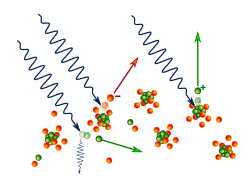
Back Paarbildung (Physik) ALS إنتاج زوجي Arabic Нараджэнне пар Byelorussian Създаване на двойка Bulgarian Creació de parells Catalan Pardannelse Danish Paarbildung (Physik) German Kreado de paro Esperanto Creación de pares Spanish Bikote sorrera Basque
This article needs additional citations for verification. (May 2013) |
| Light–matter interaction |
|---|
 |
| Low-energy phenomena: |
| Photoelectric effect |
| Mid-energy phenomena: |
| Thomson scattering |
| Compton scattering |
| High-energy phenomena: |
| Pair production |
| Photodisintegration |
| Photofission |
Pair production is the creation of a subatomic particle and its antiparticle from a neutral boson. Examples include creating an electron and a positron, a muon and an antimuon, or a proton and an antiproton. Pair production often refers specifically to a photon creating an electron–positron pair near a nucleus. As energy must be conserved, for pair production to occur, the incoming energy of the photon must be above a threshold of at least the total rest mass energy of the two particles created. (As the electron is the lightest, hence, lowest mass/energy, elementary particle, it requires the least energetic photons of all possible pair-production processes.) Conservation of energy and momentum are the principal constraints on the process.[1] All other conserved quantum numbers (angular momentum, electric charge, lepton number) of the produced particles must sum to zero – thus the created particles shall have opposite values of each other. For instance, if one particle has electric charge of +1 the other must have electric charge of −1, or if one particle has strangeness of +1 then another one must have strangeness of −1.
The probability of pair production in photon–matter interactions increases with photon energy and also increases approximately as the square of the atomic number (number of protons) of the nearby atom.[2]
- ^ Das, A.; Ferbel, T. (2003-12-23). Introduction to Nuclear and Particle Physics. World Scientific. ISBN 9789814483339.
- ^ Stefano, Meroli. "How photons interact with matter". Meroli Stefano Webpage. Retrieved 2016-08-28.